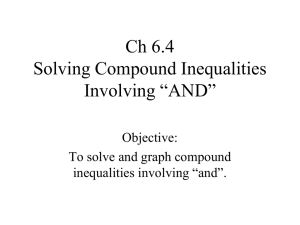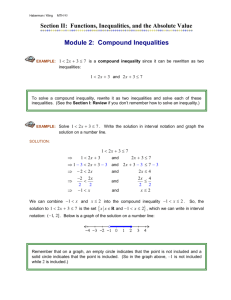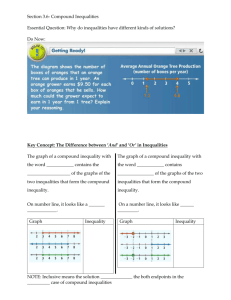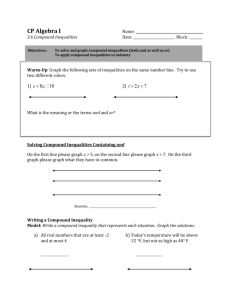Lesson 2-6(Word)
advertisement
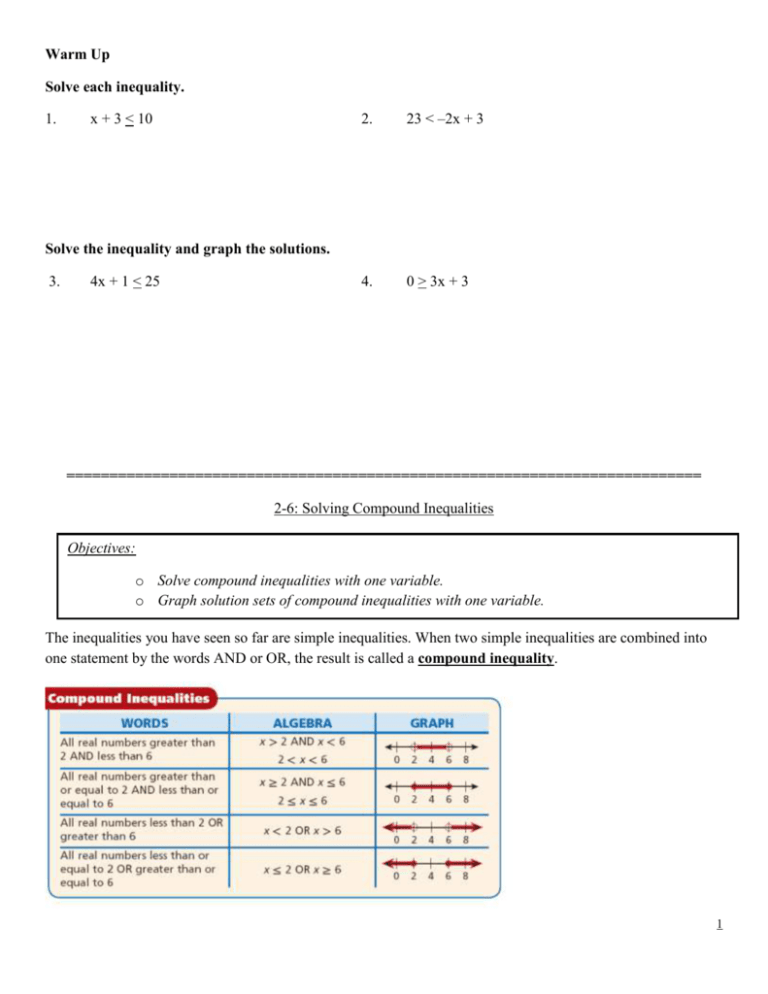
Warm Up Solve each inequality. 1. x + 3 < 10 2. 23 < –2x + 3 4. 0 > 3x + 3 Solve the inequality and graph the solutions. 3. 4x + 1 < 25 ========================================================================== 2-6: Solving Compound Inequalities Objectives: o Solve compound inequalities with one variable. o Graph solution sets of compound inequalities with one variable. The inequalities you have seen so far are simple inequalities. When two simple inequalities are combined into one statement by the words AND or OR, the result is called a compound inequality. 1 Ex 1: Chemistry Application The pH level of a popular shampoo is between 6.0 and 6.5 inclusive. Write a compound inequality to show the pH levels of this shampoo. Graph the solutions. Let p be the pH level of the shampoo. C.I.O.-Ex 1: The free chlorine in a pool should be between 1.0 and 3.0 parts per million inclusive. Write a compound inequality to show the levels that are within this range. Graph the solutions. Let c be the chlorine level of the pool. In this diagram, oval A represents some integer solutions of x < 10 and oval B represents some integer solutions of x > 0. The overlapping region represents numbers that belong in both ovals. Those numbers are solutions of both x < 10 and x > 0. 2 You can graph the solutions of a compound inequality involving AND by using the idea of an overlapping region. The overlapping region is called the intersection and shows the numbers that are solutions of both inequalities. Ex 2: Solving Compound Inequalities Involving “AND” A. Solve the compound inequality B. and graph the solutions. Solve the compound inequality and graph the solutions. –5 < x + 1 < 2 8 < 3x – 1 ≤ 11 C.I.O.-Ex 2: a. Solve the compound inequality b. Solve the compound inequality and graph the solutions. and graph the solutions. –9 < x – 10 < –5 –4 ≤ 3n + 5 < 11 3 In this diagram, circle A represents some integer solutions of x < 0, and circle B represents some integer solutions of x > 10. The combined shaded regions represent numbers that are solutions of either x < 0 or x >10. You can graph the solutions of a compound inequality involving OR by using the idea of combining regions. The combine regions are called the union and show the numbers that are solutions of either inequality. > Ex 3: Solving Compound Inequalities Involving “OR” A. Solve the compound inequality and graph the solutions. 8+t≥7 B. OR 8+t<2 Solve the compound inequality and graph the solutions. 4x ≤ 20 OR 3x > 21 4 C.I.O.-Ex 3: Solve the compound inequality and graph the solutions. a. 2 +r < 12 OR r + 5 > 19 b. 7x ≥ 21 OR 2x < –2 Every solution of a compound inequality involving AND must be a solution of both parts of the compound inequality. If no numbers are solutions of both simple inequalities, then the compound inequality has no solutions. The solutions of a compound inequality involving OR are not always two separate sets of numbers. There may be numbers that are solutions of both parts of the compound inequality. Ex 4: Writing a Compound Inequality from a Graph A. Write the compound inequality shown by the graph. B. Write the compound inequality shown by the graph. 5 C.I.O.-Ex 4: a. Write the compound inequality shown by the graph. b. Write the compound inequality shown by the graph. Lesson Quiz: Part I 1. The target heart rate during exercise for a 15 year-old is between 154 and 174 beats per minute inclusive. Write a compound inequality to show the heart rates that are within the target range. Graph the solutions. Lesson Quiz: Part II Solve each compound inequality and graph the solutions. 2. 2 ≤ 2w + 4 ≤ 12 3. 3 + r > −2 OR 3 + r < −7 6 Lesson Quiz: Part III Write the compound inequality shown by each graph. 4. 5. p. 138: 17-27 odd, 30-35, 37-41 odd Even #’s answer: 30) –6 < x < 6 32) 0 < x < 15 34) 52 < x < 58 7


